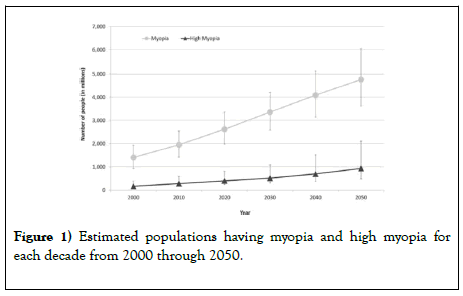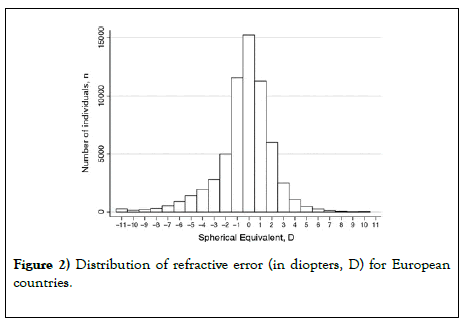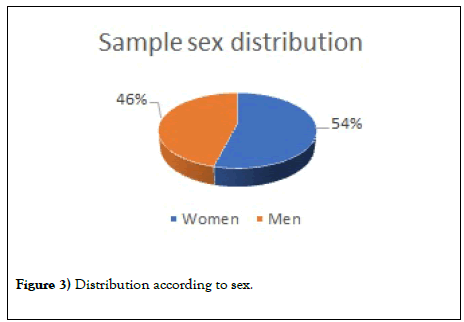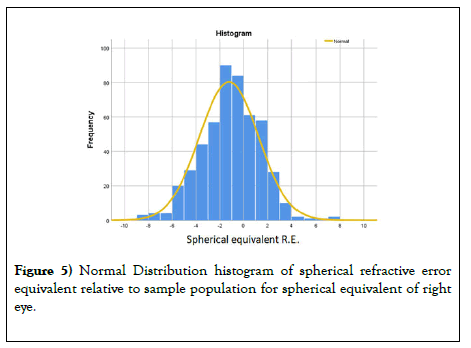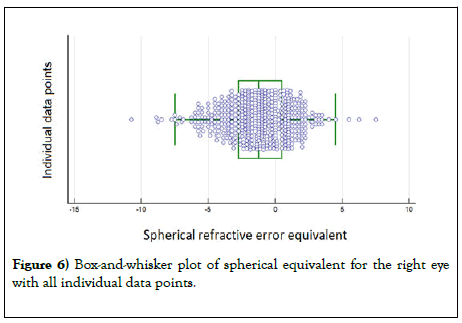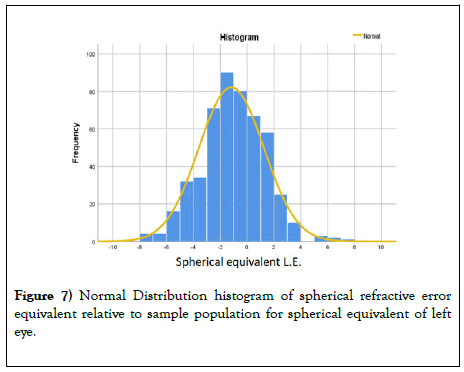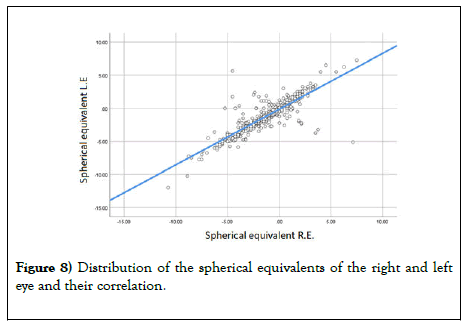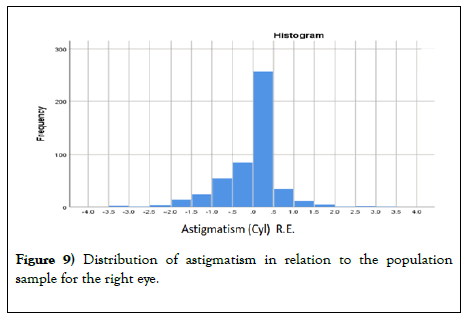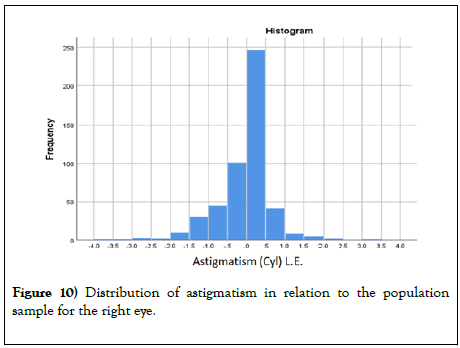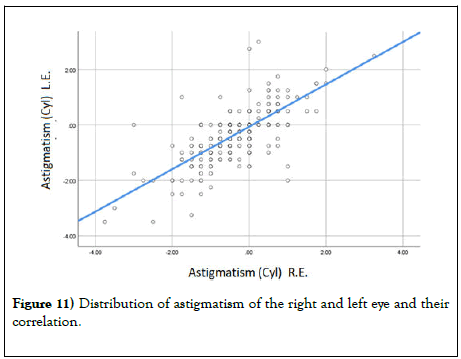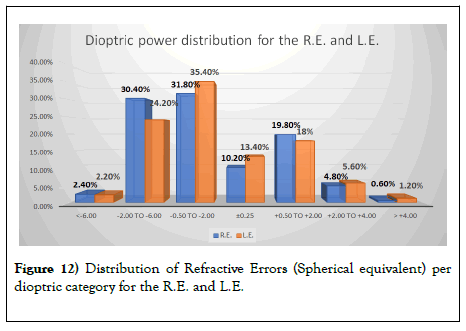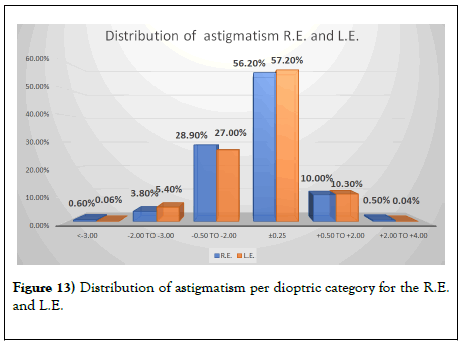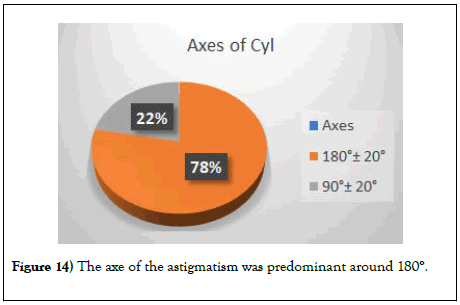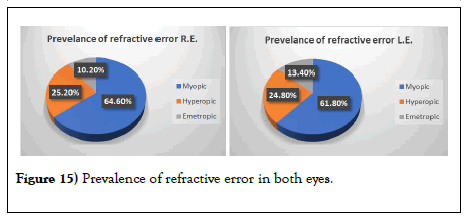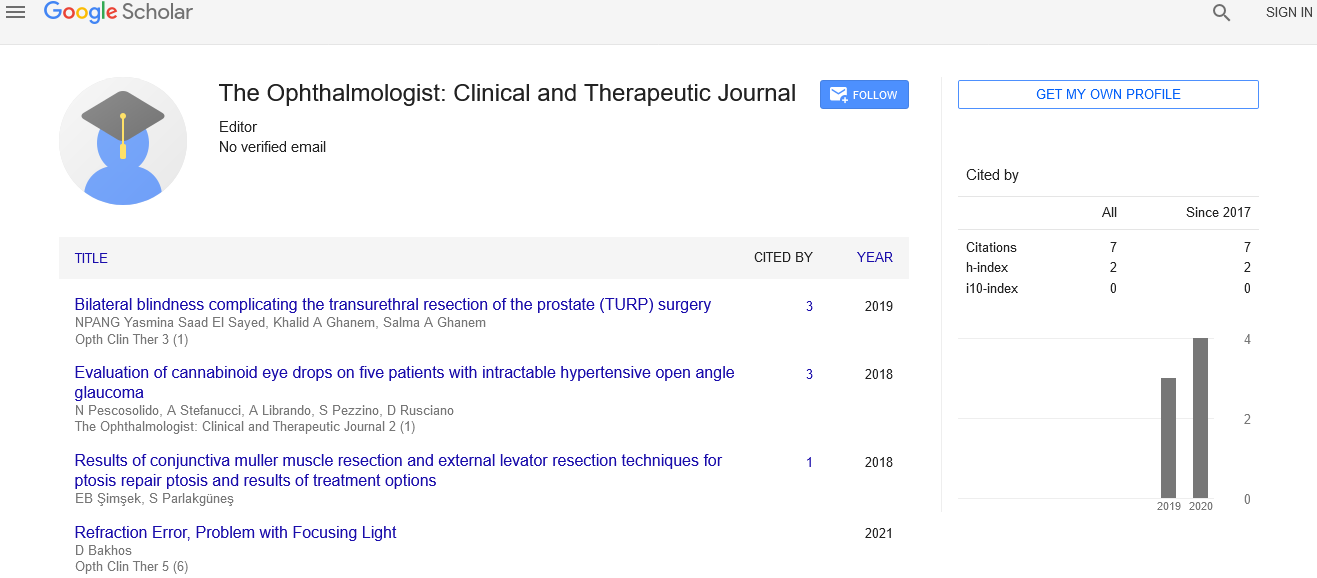Prevalence and distribution of refractive errors among adults in Athens-Greece (urban area)
Received: 20-Jul-2020 Accepted Date: Aug 04, 2020; Published: 11-Aug-2020
Citation: Evangelos P, Chrisi K. Prevalence and distribution of refractive errors among adults in Athens-Greece (urban area). Opth Clin Ther. 2020;4(2):3-8.
This open-access article is distributed under the terms of the Creative Commons Attribution Non-Commercial License (CC BY-NC) (http://creativecommons.org/licenses/by-nc/4.0/), which permits reuse, distribution and reproduction of the article, provided that the original work is properly cited and the reuse is restricted to noncommercial purposes. For commercial reuse, contact reprints@pulsus.com
Abstract
The purpose of this research is to acquire a clear image about the
distribution of refractive errors in Greece and more specific in Athens
urban area. To calculate the type and rate of refractive errors. Α comparison
of the results with those of older studies was conducted.
Material and methods: The participants were healthy adult individuals how
did not suffer from any systemic of ophthalmic diseases. The participants
were undergone automated objective refraction, and then there was a
subjective refraction in each one of them with all these selective participants
reached a visual acuity 6/6. Statistical analysis was performed in order to
categorize the results and compared with other studies.
Results: Statistical analysis has shown that the mean spherical equivalent for
the right eye was R: -1,312 D, while for the left eye was L: -1,2362 D and
there was a high degree of positive correlation between the spherical
equivalent for the right and the left eye (r=0,858).
The average astigmatic error (CYL) was checked for the right eye and found
R: -0,233 D, while for the left eye L: -0,2194 D and there was also a high
degree of positive correlation of the astigmatic error between the right and
left eye.
In general, the frequency of myopia in the majority of the sample varied
from -0,50 D to -2,00 D (R.E.: 31,80% L.E.: 35,40%prevalence) and the
frequency of hyperopia is in the majority form +0,50 D to +2,00 D (R.E.:
19,80% L.E.: 18% prevalence).
The astigmatic error is appeared with its biggest rate to be at ±0,25 with
57,20% prevalence and as for the axis of astigmatism, it appears to be 180°
±20° in most cases.
In the population sample of 500 individuals, on the right eye, the myopic
prevalence rate was 63,33% while, the hyperopic prevalence rate was
36,67%, while for the left eye, the myopic prevalence rate was 61,12% the
hyperopic prevalence rate was 38,88%.
Conclusions: The prevalence of myopia is higher in Greek adult population,
than the prevalence of hyperopia in this region. There is a difference of
more than 40%. It seems that astigmatism is not a serious refractive
problem in this region compared to the rest of the world.
Keywords
Refractive error; Myopi; Hyperopia; Astigmatism; Axis of astigmatism; Prevalence; Spherical equivalent
Introduction
The normal ocular refractive condition of the eye refers to the coupling of the eye to the optical infinity without accommodation. Under these conditions in an emmetropic eye, parallel rays of light focus on the retina. In a hyperopic eye, parallel rays of light are focused behind the retina, and in a myopic eye, the parallel rays are focused in front of the retina.
The last 30 years have seen a steady and worrying increase in the incidence of myopia in populations in Europe and Greece, especially at school age. Few years ago, statistics were published by the World Health Organization (WHO) that showed that half of the world's population (about five billion) would be myopic in 2050. These predictions are absolutely accurate if our lifestyle is not changed and not used prevention strategies. Refractive errors and especially myopia in recent years is an "epidemic" in East Asian countries (and not only), not only because its incidence rates have increased rapidly in the last 30 years, but mainly because the average eye grows significantly in size and volume, increasing the risk of retinal lesions and other eye conditions such as cataracts and glaucoma. The myopia epidemic is currently a field of concern of the World Health Organization (W.H.O.) and the main topic of discussion at world ophthalmological conferences. The growing urbanization with the increasing use of technology has put pressure on students for good academic performance and has seen the popularity of electronic devices (tablets and mobile phones) increase. The rapid increase in the prevalence of myopia worldwide is attributed to environmental factors (in the way of upbringing), which are summarized mainly in the changes that have occurred in the lifestyle of children in combination with abstinence (reduced time) in outdoor activities and increased close work, among other factors. The findings show that myopia is a major public health problem, requiring immediate planning for comprehensive vision care services necessary to manage rapid growth in high myopia. Preventive strategies can be used which may include increased outdoor time and reduced time spent on nearby activities, including electronic devices. Requiring close focus, but also new coping techniques, under-correction, Bifocals, Pals or pharmacological interventions.
It is obvious that the levels of myopia prevalence in Greece have also increased, as is the case with the average refractive error in the population, and especially in young people, which is now myopic. A comprehensive refractive examination of children should be done by the age of 6, especially since a child with emmetropia at the age of 6 is nowadays more likely to end up with myopia.
Distribution of refractive errors around the world
Uncorrected vision is the third leading cause of blindness in many developing countries. The prevalence of refractive errors (ametropias) is being monitored in many studies around the world. The World Health Organization has recently found that there are 37 million blind people, including 1.4 million children under the age of 15 and 125 million visually impaired, in a total number of visually impaired people over 160 million worldwide. The importance of awareness of the above sizes by eye health professionals is important because early and therapeutic intervention has been shown to reduce the risk of blindness and improve the quality of vision as well as the quality of life. It also heals people's psyche as it is now easier for them to integrate into society.
Numerous studies [1-14] have been carried out from time to time by many scientists and researchers, in order to understand the appearance and evolution of refractive errors in different countries of the world. An article in the American Academy of Ophthalmology, "Global Dominance of Myopia and High Myopia and Chronic Tendencies from 2000 to 2050" [15] between groups depending on the region and nationality. Data from 145 surveys with 2.1 million participants were included for the results. The study concluded that in 2020 the myopic prevalence would be 2620 million resulting to a number of 34.0% of the global population, by 2030 there would be an increase to 3361 million, 39.9% of the global population, 4089 million by 2040 representing 45.2% of the global population and by 2050 up to 4758 million around 49.8% of the global population (Figure 1 and Table 1) [15].
| Region | Prevalence (%) in Each Decade | |||||
|---|---|---|---|---|---|---|
| 2000 | 2010 | 2020 | 2030 | 2040 | 2050 | |
| Andean Latin America | 15.2 | 20.5 | 28.1 | 36.2 | 44 | 50.7 |
| Asia-Pacific, high income | 46.1 | 48.8 | 53.4 | 58 | 62.5 | 66.4 |
| Australasia | 19.7 | 27.3 | 36 | 43.8 | 50.2 | 55.1 |
| Caribbean | 15.7 | 21 | 29 | 37.4 | 45 | 51.7 |
| Central Africa | 5.1 | 7 | 9.8 | 14.1 | 20.4 | 27.9 |
| Central Asia | 11.2 | 17 | 24.3 | 32.9 | 41.1 | 47.4 |
| Central Europe | 20.5 | 27.1 | 34.6 | 41.8 | 48.9 | 54.1 |
| Central Latin America | 22.1 | 27.3 | 34.2 | 41.6 | 48.9 | 54.9 |
| East Africa | 3.2 | 4.9 | 8.4 | 12.3 | 17.1 | 22.7 |
| East Asia | 38.8 | 47 | 51.6 | 56.9 | 61.4 | 65.3 |
| Eastern Europe | 18 | 25 | 32.2 | 38.9 | 45.9 | 50.4 |
| North Africa and Middle East | 14.6 | 23.3 | 30.5 | 38.8 | 46.3 | 52.2 |
| North America,high income | 28.3 | 34.5 | 42.1 | 48.5 | 54 | 58.4 |
| Oceania | 5 | 6.7 | 9.1 | 12.5 | 17.4 | 23.8 |
| South Asia | 14.4 | 20.2 | 28.6 | 38 | 46.2 | 53 |
| Southeast Asia | 33.8 | 39.3 | 46.1 | 52.4 | 57.6 | 62 |
| Southern Africa | 5.1 | 8 | 12.1 | 17.5 | 23.4 | 30.2 |
| Southern Latin America | 15.6 | 22.9 | 32.4 | 40.7 | 47.7 | 53.4 |
| Tropical Latin America | 14.5 | 20.1 | 27.7 | 35.9 | 43.9 | 50.7 |
| West Africa | 5.2 | 7 | 9.6 | 13.6 | 19.7 | 26.8 |
| Western Europe | 21.9 | 28.5 | 36.7 | 44.5 | 51 | 56.2 |
| Global | 22.9 | 28.3 | 33.9 | 39.9 | 45.2 | 49.8 |
Table 1: Prevalence of Myopia Estimated globaly between 2000 and 2050.
In addition, several studies have been conducted in European countries. According to the 2015 article "Prevalence of refractive error in Europe: European Eye Epidemiology Consortium" [16], a Meta-analysis of refractive error was performed taking into account 15 surveys of 61.946 participants aged 44 to 78 The data was collected between 1990 and 2013. The distribution of refractive error appears to be subtle (ie with a high concentration of values around the mean) with a mean spherical equivalent of -0.56D but also asymmetric due to the more frequent occurrence of individuals with a negative refractive error. Data from a post-analysis of 15 studies in Europe show that 30.6% of myopia, 25.2% of hyperopia and 23.9% of astigmatism predominate. There are no significant differences in the prevalence of myopia between men and women. There is a higher prevalence of astigmatism in men and more cases of hyperopia in women of all ages. The European population presenting myopia was estimated to be around 227.2 million in 2010 (Figure 2) [12].
In 2012 a survey was conducted for the city of Athens in Greece [17], according to which, in a sample of 1500 people aged 44 to 70 in the northern suburbs of Athens, the prevalence of myopia was found at 43.27% with the majority having low grade (≤-2.00D), while the hyperopia at 14.40% also with the majority not exceeding + 2.00D. The emmetropia in this study was 42.33%. The results of the study also concluded that there was no significant differentiation depending gender, while the refractive error varies with age, observing hyperopia increase in participants over 70 years.
Materials and Methods
Place and duration of study
The data were collected from a sample of 500 people which were examined, at “Athens Ophthalmiatrio Clinic” during the period between January 2019 until October 2019, who were randomly selected by residents of central and northern suburbs.
Study design
For the selection of the sample, individuals who have undergone any refractive or cataract surgery or who have a systemic condition that alters or affects the refraction, retinal detachment, macular degeneration or any other ophthalmic disease, RGP contact lenses, as well as people who develop keratoconus, were excluded. All the participants of this study reached an objective monocular visual acuity of 6/6 otherwise they were excluded. According to the data 46% were men and 54% were women aged from 25 to 55 years old, all other participants outside the age group of 25-55 years old were excluded also (Figures 3 and 4).
Materials
For the part of the objective measurement test, an automatic SHIN-NIPPON 9001 refractometer was used. Subsequently (non-cycloplegic refraction), in terms of subjective measurement, visual acuity was measured with a Snellenoptotype, under normal lighting conditions. Using the results of objective refraction as a guide, subjective refraction was performed reaching the best correction respectively for the right and left eye final V.A. for both eyes 6/6.
The final refraction was recorded and the spherical equivalent (sphere + 1/2 cylinder) was used to calculate the refractive error. The statistical analysis was performed with a MedCalc computer program.
Results
Statistical analysis of spherical equivalent values of the right and left eye (Table 2) (Figures 5-7).
| Spherical equivalent | Right Eye | Left Eye |
|---|---|---|
| Sample size | 500 | 500 |
| Arithmetic mean | -1.312 | -1.2352 |
| 95% CI for the mean | -1.5264 to -1.0975 | - 1.4460 to – 1.0245 |
| Median | -1.25 | -1.25 |
| Variance | 5.945 | 5.7416 |
| Standard Deviation | 2.4382 | 2.3962 |
| Standard error of the mean | 0.1092 | 0.1073 |
| Coefficient of Skewness | -0.2728 (P=0.0134) | -0.1904 (P=0.0816) |
Table 2: Statistics on the refractive error of spherical equivalent in the right and the left eye of the population sample.
Correlation of spherical equivalent for the right and left eye (Figure 8).
Statistical analysis of astigmatism for the right and left eye (Table 3) (Figures 9 and 10).
| Astigmatism | Right Eye | Left Eye |
|---|---|---|
| Sample size | 500 | 500 |
| Arithmetic mean | -0.233 | -0.2194 |
| 95% CI for the mean | -0.2965 to -0.1694 | -0.2805 to -0.1583 |
| Variance | 0.5215 | 0.4813 |
| Standard Deviation | 0.7222 | 0.6938 |
| Standard error of the mean | 0.03233 | 0.03109 |
| Coefficient of Skewness | -0.5996 (P<0.0001) | -0.7562 (P<0.0001) |
Table 3: Statistics on the refractive error of astigmatism in the right and left eye of the population sample.
Correlation of astigmatism for the right and left eye (Figures 11-15).
This study provides data on the prevalence and distribution of refractive errors (ametropia) in a sample of 500 adults in the central suburbs of Athens.
The arithmetic mean of refractive error (spherical equivalent) was checked for the right eye on average R.E.: -1,312 D with 95% ranging from -1,52 D to -1,097 D. The standard deviation is 2,438. The distribution of the spherical equivalent in relation to the population sample for the right eye has a Coefficient of skewness -0,2728 and Coefficient of kurtosis 0,6979. In the left eye, the arithmetic mean was L.E.: -1.2352 D and 95% ranges between -1.4460 D to -1.0245 D. The standard deviation is 2.3962. The distribution of the spherical equivalent in relation to the population sample for the left eye has a Coefficient of skewness -0,1904 and Coefficient of kurtosis 1,1017. There was a high degree of positive correlation between spherical equivalents of right and left eye (Correlation coefficient r=0.858). All values around ± 0.25 D considered to beemetropic.
Regarding the refractive error (spherical equivalent) rates per dioptric category, the right eye presented hyperopia more than>+4.00 D 0.60%, from +2.00 D up to +4.00 D 4.80%, from +0.50 D to +2.00 D 19.80% and ± 0.25 D 10.20%. The myopic refractive error ranged from -0.50 D to -2.00 D 31.80%, from -2.00 D to -6.00 D 30.40% and>-6.00D 2.40%.
The left eye presented hyperopia more than>+4.00 D 1.20%, from +2.00 D up to +4.00 D 5.60%, from +0.50 D to +2.00 D 18.00% and ± 0.25 D 13.40%. The myopic refractive error ranged from -0.50 D to -2.00 D 35.40%, from -2.00 D to -6.00 D 24.20% and>-6.00D 2.20%.
The arithmetic mean of astigmatism was checked for the right eye on average R.E.: -0.2330 D with 95% ranging from -0.2965 to -0.1694 D. The standard deviation is 0.7222. In the left eye, the arithmetic mean was L.E.: -0.2194 D and 95% ranges between -0.2805 to -0.1583 D.
The right eye presented hyperopic astigmatism from +2.00 D up to +4.00 D 0.50%, from +0.50 D to +2.00 D 10.00% and ± 0.25 D 56.20%. The myopic astigmatism ranged from -0.50 D to -2.00 D 28.90%, from -2.00 D to -3.00 D 3.80% and>-3.00D 0.60%.
The left eye presented hyperopic astigmatism from +2.00 D up to +4.00 D 0.04%, from +0.50 D to +2.00 D 10.30% and ± 0.25 D 57.20%. The myopic astigmatism ranged from -0.50 D to -2.00 D 27.00%, from -2.00 D to -3.00 D 5.40% and>-3.00D 0.06%.
The spherical equivalent in this study for the right and left eye had a mean of R.E.: -1,312 D compared to the study of 2012 with R.E.: – 0.6907 while for the left eye it was L.E.: -1.2352 D compared with L.E.: -0.7458 showing a trend to increase the last 8 years around 0.50 D a diopter. Astigmatic mean is R.E.: -0.2330 and L.E.: -0.2194 which is smaller than the study of 2012 (0.7297). The prevalence rates also in this study show an increase for myopia (63.2% compared to the study of 2012 which was 42.67%), hypermetropia (25% compared to the study of 2012 which was 14.40%), while for emmetropia there was a decrease (11,80% compared to the study of 2012 which was 42.33%).
The difference between the two studies shows a significant increase in myopia more than 20% and 10% for hyperopia while there is a significant decrease of the emmetropic population. Regardless the global study [15] for myopia the prediction for Central Europe was 34.6% [28.6% raise], Eastern Europe 32.2% [31.00% raise] and East Asia 51.6% [11.60% raise], it seems to be higher than the prediction. This is probably due to that all participants agreed to participate in the study after coming voluntarily to the clinic for an optometric control regardless their vision efficacy and actually it was a random sample selected. This is the reason that the clearly emmetropic patients correspond to a small percentage in the sample compared to the ametropic one. The high percentage of myopia and hyperopia compared with the 2012 study or other studies is due to the fact that all the participants came for an optometric control either complaining about their vision quality or that they had a suspicion of blurred vison.
Regarding our country, a study, conducted in 2007 by the University of Crete, showed that the prevalence of myopia, among students aged 10 to 16 years, was 37.2%. Significantly increased prevalence of myopia has recently been observed in European countries, including Greece [18].
Conclusion
Refractive errors are considered to be an impairment of vision and there are a lot of efforts to overcome this problem. Myopia in recent years is an "increasing epidemic" in East Asian countries but also in other parts of the world. Its incidence rates have increased rapidly in the last 30 years, mainly because the average eye grows significantly in size and volume (axial length), increasing the risk of retinal lesions and other eye diseases decreasing the visual acuity and making the life of millions of people difficult.
The growing urbanization with the increasing use of technology and the popularity of electronic devices (computers, laptops, smartphones, tablets) increase and so the myopic prevalence in young populations. According to a study published in International Journal Ophthalmology, half of the world's population (about five billion) will be myopic in 2050. The number of patients with vision loss from high myopia is expected to increase sevenfold between 2000 and 2050, with myopia becoming one of the leading causes of permanent blindness worldwide.
It is obvious that the prevalence levels of myopia in Greece have also increased, as is the case with the average refractive error (spherical equivalent) in the population, and especially in young people, who are now mostly myopic. Hyperopia on the other hand is related to glaucoma and other ocular diseases, so it is a necessity to monitor globally. Astigmatism also affect the vision of millions of people and distort the geometry of the image perception. Comparing this study with the prediction for the future it seems that an acceleration of all refractive errors takes place so there should be constant update on the percentage and the level of each type of refractive error.
REFERENCES
- Bourne RR, Stevens GA, White RA, et al. Causes of vision loss worldwide, 1990-2010: a systematic analysis. Lancet Global Health. 2013; 1: e339–e349.
- Iwase A, Araie M, Tomidokoro A, et al. Prevalence and causes of low vision and blindness in a Japanese adult population: the Tajimi study. Ophthalmology. 2006; 113: 1354-62.
- International statistical classification of diseases and related health problems, 10th revision, version for 2010. Geneva: World Health Organization. 2010.
- Sheeladevi S, Seelam B, Nukella PB, et al. Prevalence of refractive errors, uncorrected refractive error, and presbyopia in adults in India: A systematic review. Indian J Ophthalmol. 2019; 67: 583-92.
- Varma R, Torres M, McKean-Cowdin R, et al. Prevalence and Risk Factors for Refractive Error in Adult Chinese Americans: The Chinese American Eye Study. American Journal of Ophthalmology. 2017; 175: 201-12.
- Wang M, Cui J, Shan G, et al. Prevalence and risk factors of refractive error: a cross-sectional Study in Han and Yi adults in Yunnan, China. BMC Ophthalmol. 2019; 19: 33.
- Mashige KP, Jaggernath J, Ramson P, et al. Prevalence of Refractive Errors in the INK Area, Durban, South Africa Optometry and Vision Science: March 2016; 93: 243-50.
- Muhit M, Minto H, Parvin A, et al. Prevalence of refractive error, presbyopia, and unmet need of spectacle coverage in a northern district of Bangladesh: Rapid Assessment of Refractive Error study. Ophthalmic Epidemiology. 2018; 25: 126-32.
- Vitale S. Prevalence of refractive error in the United States, 1999–2004. Arch Ophthalmol. 2008; 126: 1111–19.
- Pan CH, Zheng YF, Anuar AR, et al. Prevalence of Refractive Errors in a Multiethnic Asian Population: The Singapore Epidemiology of Eye Disease Study. Investigative Ophthalmology & Visual Science. 2013; 54: 2590-98.
- Ezelum C, Razavi H, Sivasubramaniam S, et al. Refractive Error in Nigerian Adults: Prevalence, Type, and Spectacle Coverage. Investigative Ophthalmology & Visual Science. 2011; 52: 5449-56.
- Pi LH, Chen L, Liu Q, et al. Refractive Status and Prevalence of Refractive Errors in Suburban School-age Children. Int J Med Sci. 2010; 7: 342-53.
- Garcia CAA, Oréfice F, Nobre GFD, et al. Prevalence of refractive errors in students in Northeastern Brazil. Arq. Bras. Oftalmol. 2005; 68: 321-25.
- Yang L, Vass C, Smith L, et al. Thirty-five-year trend in the prevalence of refractive error in Austrian conscripts based on 1.5 million participants. British Journal of Ophthalmology. 2020.
- Holden BA, Fricke TR, Wilson DA, et al. Global Prevalence of Myopia and High Myopia and Temporal Trends from 2000 through 2050. Ophthalmology. 2016; 123: 1036-42.
- Williams KM, Verhoeven VJM, Cumberland P, et al. Prevalence of refractive error in Europe: the European Eye Epidemiology (E3) Consortium. Eur J Epidemiol. 2015; 30: 305-15.
- Pateras E. Prevalence of refractive errors amongst adults, located at the north suburbs of Athens-Greece. Health Science Journal. 2012; 6: 102-14.
- Plainis S, Moschandreas J, Nikolitsa P, et al. Myopia and visual acuity impairment: a comparative study of Greek and Bulgarian school children. Ophthalmic and Physiological Optics. 2009; 29: 312-20.




